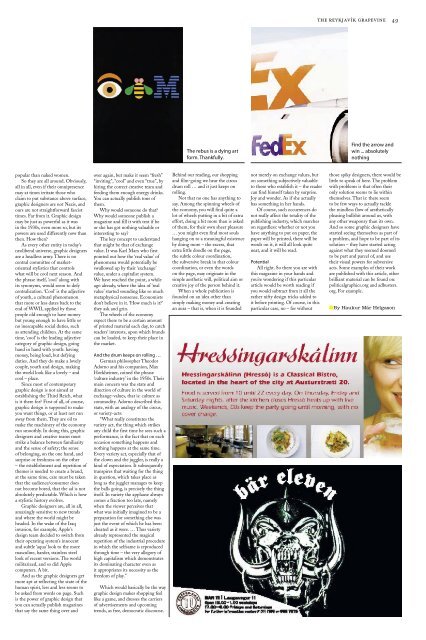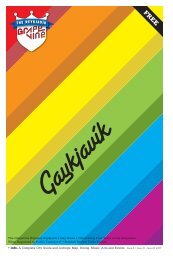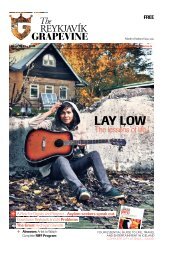7 august - The Reykjavik Grapevine
7 august - The Reykjavik Grapevine
7 august - The Reykjavik Grapevine
You also want an ePaper? Increase the reach of your titles
YUMPU automatically turns print PDFs into web optimized ePapers that Google loves.
popular than naked women.<br />
So they are all around. Obviously,<br />
all in all, even if their omnipresence<br />
may at times irritate those who<br />
claim to put substance above surface,<br />
graphic designers are not Nazis, and<br />
ours are not straightforward fascist<br />
times. Far from it. Graphic design<br />
may be just as powerful as it was<br />
in the 1930s, even more so, but its<br />
powers are used differently now than<br />
then. How then?<br />
As every other entity in today’s<br />
neoliberal universe, graphic designers<br />
are a headless army. <strong>The</strong>re is no<br />
central committee of marketoriented<br />
stylistics that controls<br />
what will be cool next season. And<br />
the phrase itself, ‘cool’ along with<br />
its synonyms, would seem to defy<br />
centralization. ‘Cool’ is the adjective<br />
of youth, a cultural phenomenon<br />
that more or less dates back to the<br />
end of WWII, applied by those<br />
people old enough to have money<br />
but young enough to have little or<br />
no inescapable social duties, such<br />
as attending children. At the same<br />
time, ‘cool’ is the leading adjective<br />
category of graphic design, going<br />
hand in hand with youth: having<br />
money, being loud, but defying<br />
duties. And they do make a lovely<br />
couple, youth and design, making<br />
the world look like a lovely – and<br />
cool – place.<br />
Since most of contemporary<br />
graphic design is not aimed at<br />
establishing the Third Reich, what<br />
is it there for? First of all, of course,<br />
graphic design is supposed to make<br />
you want things, or at least not run<br />
away from them. <strong>The</strong>y are oil to<br />
make the machinery of the economy<br />
run smoothly. In doing this, graphic<br />
designers and creative teams must<br />
strike a balance between familiarity<br />
and the sense of safety; the sense<br />
of belonging, on the one hand, and<br />
surprise or freshness on the other<br />
– the establishment and repetition of<br />
themes is needed to create a brand,<br />
at the same time, care must be taken<br />
that the audience/consumer does<br />
not become bored, that the ad is not<br />
absolutely predictable. Which is how<br />
a stylistic history evolves.<br />
Graphic designers are, all in all,<br />
amazingly sensitive to new trends<br />
and where the world might be<br />
headed. In the wake of the Iraq<br />
invasion, for example, Apple’s<br />
design team decided to switch from<br />
their operating system’s innocent<br />
and subtle ‘aqua’ look to the more<br />
masculine, harder, stainless steel<br />
look of recent versions. <strong>The</strong> world<br />
militarized, and so did Apple<br />
computers. A bit.<br />
And as the graphic designers get<br />
more apt at reflecting the state of the<br />
human spirit, less and less seems to<br />
be asked from words on page. Such<br />
is the power of graphic design that<br />
you can actually publish magazines<br />
that say the same thing over and<br />
over again, but make it seem “fresh”<br />
“inviting”, “cool” and even “true”, by<br />
hiring the correct creative team and<br />
feeding them enough energy drinks.<br />
You can actually publish tons of<br />
them.<br />
Why would someone do that?<br />
Why would someone publish a<br />
magazine and fill it with text if he<br />
or she has got nothing valuable or<br />
interesting to say?<br />
<strong>The</strong> key concept to understand<br />
that might be that of exchange<br />
value. It was Karl Marx who first<br />
pointed out how the ‘real value’ of<br />
phenomena would potentially be<br />
swallowed up by their ‘exchange’<br />
value, under a capitalist system.<br />
We have reached the point, a while<br />
ago already, where the idea of ‘real<br />
value’ started sounding like so much<br />
metaphysical nonsense. Economists<br />
don’t believe in it. ‘How much is it?’<br />
they ask and grin.<br />
<strong>The</strong> wheels of the economy<br />
expect there to be a certain amount<br />
of printed material each day, to catch<br />
readers’ interests, upon which brands<br />
can be loaded, to keep their place in<br />
the market.<br />
And the drum keeps on rolling …<br />
German philosopher <strong>The</strong>odor<br />
Adorno and his companion, Max<br />
Horkheimer, coined the phrase<br />
‘culture industry’ in the 1950s. <strong>The</strong>ir<br />
main concern was the state and<br />
direction of culture in the world of<br />
exchange-values, that is: culture as<br />
commodity. Adorno described this<br />
state, with an analogy of the circus,<br />
or variety-acts:<br />
“What really constitutes the<br />
variety act, the thing which strikes<br />
any child the first time he sees such a<br />
performance, is the fact that on each<br />
occasion something happens and<br />
nothing happens at the same time.<br />
Every variety act, especially that of<br />
the clown and the juggler, is really a<br />
kind of expectation. It subsequently<br />
transpires that waiting for the thing<br />
in question, which takes place as<br />
long as the juggler manages to keep<br />
the balls going, is precisely the thing<br />
itself. In variety the applause always<br />
comes a fraction too late, namely<br />
when the viewer perceives that<br />
what was initially imagined to be a<br />
preparation for something else was<br />
just the event of which he has been<br />
cheated as it were. … Thus variety<br />
already represented the magical<br />
repetition of the industrial procedure<br />
in which the selfsame is reproduced<br />
through time – the very allegory of<br />
high capitalism which demonstrates<br />
its dominating character even as<br />
it appropriates its necessity as the<br />
freedom of play.”<br />
Which would basically be the way<br />
graphic design makes shopping feel<br />
like a game, and dresses the carriers<br />
of advertisements and upcoming<br />
trends, as free, democratic discourse.<br />
<strong>The</strong> rebus is a dying art<br />
form. Thankfully.<br />
Behind our reading, our shopping<br />
and film-going we hear the circus<br />
drum roll … and it just keeps on<br />
rolling.<br />
Not that no one has anything to<br />
say. Among the spinning wheels of<br />
the economy, you will find quite a<br />
lot of wheels putting in a bit of extra<br />
effort, doing a bit more than is asked<br />
of them, for their own sheer pleasure<br />
… you might even find most souls<br />
hanging on to a meaningful existence<br />
by doing more – the excess, that<br />
extra little doodle on the page,<br />
the subtle colour coordination,<br />
the subversive break in that colour<br />
coordination, or even the words<br />
on the page, may originate in the<br />
simple aesthetic will, political aim or<br />
creative joy of the person behind it.<br />
When a whole publication is<br />
founded on an idea other than<br />
simply making money and creating<br />
an aura – that is, when it is founded<br />
not merely on exchange values, but<br />
on something subjectively valuable<br />
to those who establish it – the reader<br />
can find himself taken by surprise.<br />
Joy and wonder. As if she actually<br />
has something in her hands.<br />
Of course, such occurrences do<br />
not really affect the totality of the<br />
publishing industry, which marches<br />
on regardless: whether or not you<br />
have anything to put on paper, the<br />
paper will be printed, there will be<br />
words on it, it will all look quite<br />
neat, and it will be read.<br />
Potential<br />
All right. So there you are with<br />
this magazine in your hands and<br />
you’re wondering if this particular<br />
article would be worth reading if<br />
you would subtract from it all the<br />
rather nifty design tricks added to<br />
it before printing. Of course, in this<br />
particular case, no – for without<br />
Find the arrow and<br />
win ... absolutely<br />
nothing<br />
49<br />
those spiky designers, there would be<br />
little to speak of here. <strong>The</strong> problem<br />
with problems is that often their<br />
only solution seems to lie within<br />
themselves. That is: there seem<br />
to be few ways to actually tackle<br />
the mindless flow of aesthetically<br />
pleasing bullshit around us, with<br />
any other weaponry than its own.<br />
And so some graphic designers have<br />
started seeing themselves as part of<br />
a problem, and hope to be part of its<br />
solution – they have started acting<br />
against what they seemed doomed<br />
to be part and parcel of, and use<br />
their visual powers for subversive<br />
acts. Some examples of their work<br />
are published with this article, other<br />
brilliant material can be found on:<br />
politicalgraphics.org and adbusters.<br />
org. For example.<br />
By Haukur Már Helgason










